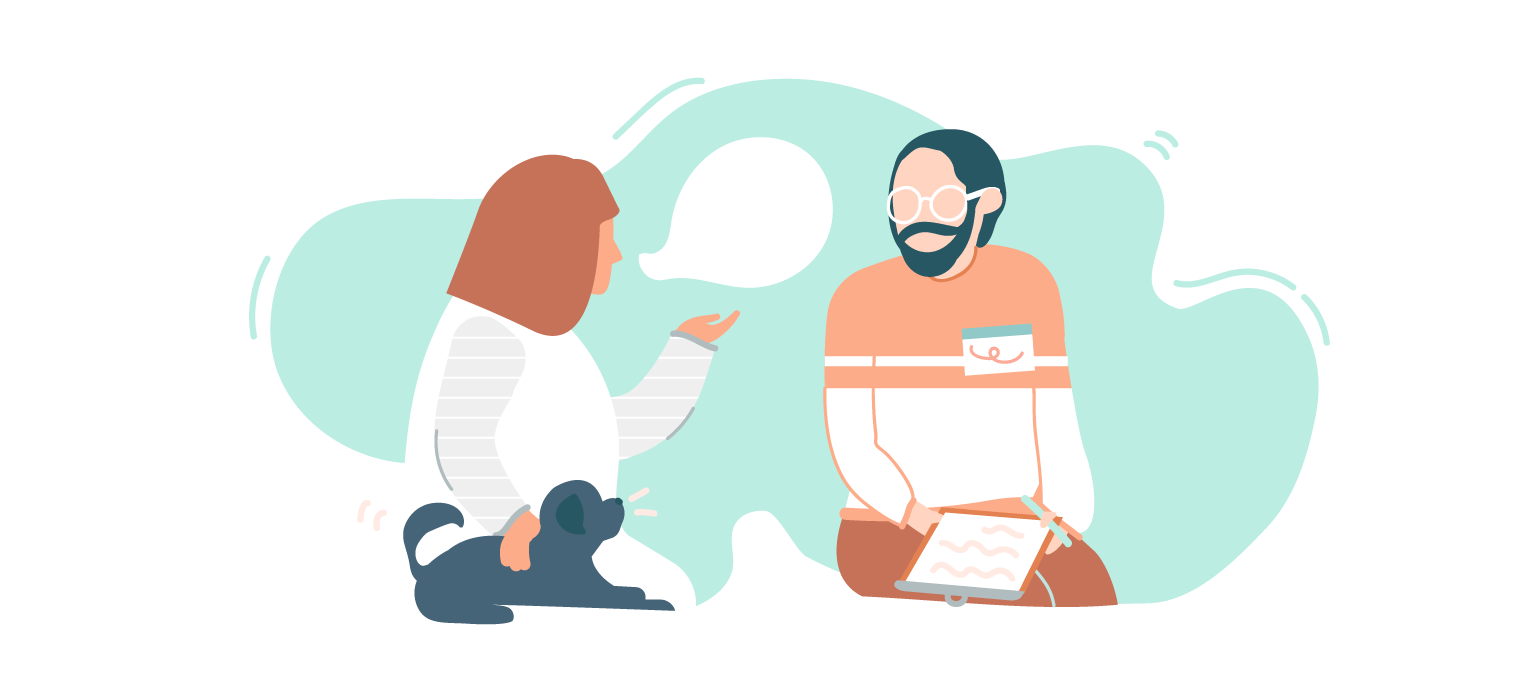Understanding Animal-Assisted Interventions and Veterinary Social Work

While most pet owners may see themselves as a caregiver for their animal, veterinary social worker Rachel Wright, MSW, LSWAIC, helps her clients reverse roles with therapy animals.
“Maybe [the client] didn’t get physical affection or nurturing from a parent,” Wright said. “So, we’ll work on being able to receive that love from an animal.”
Role-playing is one of many strategies Wright uses for animal-assisted interventions, along with modeling behaviors, which help clients build communication skills, self-esteem and coping skills for grief and loss.
Wright said she might say to a client, “What’s the animal doing right now to take care of themselves? They’re drinking water. They’re taking a break. They’re eating a treat.”
Wright has had her clients look to the animal as a role model of self-care and self-discipline, and even sometimes as an opportunity to address difficulties with attachment or addiction recovery. However, animal-assisted interventions aren’t as simple as spending time petting an animal or bringing your pet to work.
“Making the right pairing is part of a social worker’s role in helping a client work toward their personal and mental health goals and can transform a person’s relationship with themselves, their loved ones and their environment.”
“Both the client and the animal have to be properly screened to ensure a good fit,” Wright said. Different species of animals have key behavioral qualities that make them therapeutic and beneficial companions. Wright said making the right pairing is part of a social worker’s role in helping a client work toward their personal and mental health goals and can transform a person’s relationship with themselves, their loved ones and their environment.
“We attach to animals in a similar way that we attach to the people in our lives,” she said.
What Are Animal-Assisted Interventions?
“Animal-assisted interventions” is an umbrella term that includes a variety of methods in which animals participate in therapeutic practices that are beneficial to humans by promoting the human-animal bond.
The American Veterinary Medical Association states that animal-assisted interventions “should be governed by basic standards, be regularly monitored, and be staffed by appropriately trained personnel. Animal-assisted interventions should adhere to best practice and have goals (in the areas of health, wellbeing or education) with measurable outcomes. The health and welfare of the humans and animals involved must be ensured.”
Interventions can include many approaches, methodologies and goals — all of which can be better understood through key terminology used by the AVMA and individual professionals.
Commonly Used Terms Related to Animal-Assisted Interventions

Animal-Assisted Therapy
- Goal-oriented counseling or therapy sessions.
- Facilitated by a licensed counselor or social worker.
- Animal and human participate in the treatment process.
- Animal lives with the clinician full time.
- Animal is trained to participate in therapy.
Example: A social worker brings their trained therapy dog to the office when conducting weekly sessions for a grief support group and integrates it into role-playing scenarios with the clients.

Animal-Assisted Activity
- Informal goal-oriented activities.
- Facilitated by a licensed counselor, social worker or volunteer.
- Animal and human participate in the activity.
- Animal lives at a professional facility or with the clinician full time.
- Animal is trained to participate in therapeutic activities.
Example: A group of social work volunteers brings trained therapy animals to a college campus to play with students during final exams with a goal of stress relief and anxiety reduction.

Animal-Assisted Education
- Goal-oriented, structured activities with an academic or educational purpose.
- Facilitated by a special education or service-related professional.
- Animal and human participate in educational session.
- Animal lives with education professional or at a long-term facility.
- Animal is trained to participate in educational activities.
Example: A special education teacher implements a dog-assisted reading program in which students practice reading to calm, well-trained dogs to promote social skills and self-esteem with reading comprehension.

Emotional Support Animal
- Long-term guardianship of an animal for mental health reasons.
- Prescribed by a licensed counselor or mental health professional.
- Animal does not have to participate or engage in specified activities
- Animal is not necessarily professionally trained.
- Animal lives with the emotional-support recipient full time.
Example: A counselor diagnoses a person with clinical depression and recommends adopting a cat to provide companionship and mitigate feelings of isolation.

Service Animal
- Long-term task-oriented support from an animal for a person with disabilities.
- Prescribed by a licensed health care professional and protected by the Americans with Disabilities Act.
- Animal routinely performs specific tasks or services related to health and safety.
- Animal is professionally trained.
- Animal lives with the service recipient full time.
Example: A woman brings her seizure-alert dog with her to the workplace, restaurants and her apartment in case of an emergency related to her epilepsy.
Understanding the difference between key terms can help clients and professionals be clearer about their goals and methods for pursuing animal-assisted interventions.
Wright said that conflating emotional support animals with service animals delegitimizes the work that service animals do and can ultimately undercut the public access that service animals have for people with disabilities
Another common misconception is the use of the term “pet therapy.” Allison Rolfe, MSW, said “pet therapy” is not only clinically inaccurate but also a vague descriptor that can be easily misinterpreted by anyone who might assume that the therapeutic services are for the animal or that the animal is “used” to heal a person.
“Animals are not the focus of the therapy session but rather an additional healing modality in the counseling process.”
“It also takes away from the professionalism of the social worker,” said Rolfe, who works as a veterinary social worker on a team with Wright at the Summit Veterinary Referral Center.
When considering any type of intervention that involves a pet, it’s critical to prioritize safety and intentionality for the animals. Wright said animals are not the focus of the therapy session but rather an additional healing modality in the counseling process.
“They’re never ‘used,’ because they’re our partners,” she said.
Therapy animals are trained and integrated into clinical interventions to help clients achieve a variety of goals and work on building interrelation skills by interacting with each other during therapy sessions.
Emotional support animals, on the other hand, may be trained to help a person achieve goals related to mental health issues and diagnoses, depending on the animal and a mental health care professional’s recommendation.
Benefits of Animal-Assisted Therapy:
- Building rapport
- Increasing self-esteem and confidence
- Addressing relational conflict
- Exploring grief and loss
- Modeling self-care and social behavior
Benefits of Emotional Support Animals:
- Developing long-term companionship
- Reducing anxiety or stress
- Increasing self-esteem
- Creating a sense of purpose through caregiving
- Building compassion and empathy
“Creating additional yet responsible opportunities for human-animal interaction enhances people’s lives,” said Cynthia Chandler in an article about emotional support animals for Counseling Today.
Understanding the level of responsibility required to have an emotional support animal is a key consideration.
“First and foremost, any emotional support animal really does need to have a good foundation of basic and advanced obedience and be able to be a reliable, predictable partner,” Wright said.
Adopting an emotional support animal requires full-time care beyond the supervision of a social worker or counselor, so it’s important to understand an animal’s capacity for emotional support, predictability, temperament and other factors that will influence a human-animal bond. A social worker with a veterinary expertise can help evaluate and match clients with the right animal and style of intervention.
How Can a Veterinary Social Worker Help With Animal-Assisted Therapy?
Veterinary social workers have specialized expertise working with animals, people and care providers like veterinarians and counselors. They work in a variety of professional settings, including animal hospitals, animal shelters, mental health care facilities, private practices and human hospitals.
“We act as a liaison and bridge gaps between medical teams and clients,” Rolfe said. “We’re making sure that everyone is getting the answers and information they need to make the best decision.”
Some veterinary social workers can bring trained therapy animals to a person’s home, assisted living facility or other residence for a visit and counseling session.
“We come with a different perspective than a medical perspective,” Rolfe said. “We come from a social work framework of care for the people and for the animals.”
The Role of a Veterinary Social Worker
- Communicate between people and animals, and between visitors and veterinary staff
- Offer grief counseling and other types of support for people who have lost a pet or beloved animal
- Train and certify animals to participate in interventions
- Evaluate clients’ compatibility for animal-assisted interventions
- Conduct animal-assisted therapy or other interventions for clients
- Offer therapeutic counseling for people who work with animals, like veterinary staff, trainers and shelter staff
- Maintain care and safety for therapy animals during and after sessions
- Recommend resources for people seeking specific types of animal-assisted interventions
“A big part of what we do is help veterinary staff process emotions of working every day with sick and dying animals,” Rolfe said. “We help them to communicate better with the clients and within their teams, to provide better care for animals and their clients, and for them to have better wellness and mental health while working in this area.”
Rolfe said that while there isn’t a veterinary social worker at every hospital or animal hospital, it’s a goal of the growing profession to spread awareness of the benefits and opportunities they bring. Rolfe and Wright said they hope the presence of a veterinary social worker becomes a common and accessible position at animal hospitals across the country.
The grief of losing an animal “is disenfranchised in our community,” she said. “We validate that experience for pet owners and people with companion animals to say everything they’re feeling is normal and support them around those decisions in the entire process.”
Veterinary social workers also spend equal effort advocating for and ensuring the safety and well-being of the animals they work with.
“Not every animal is going to be a good fit, and it’s not going to make every animal happy,” Rolfe said. “We really have to communicate with the animal to make sure that it’s a good fit for them.”
That advocacy includes facilitating bathroom breaks, routine mealtimes and breaks during and after sessions.
“You have to be able to really read animal body language and animal behavior and know calming signals or stress signals in the animal,” Wright said.
What to Know Before Pursuing Animal-Assisted Intervention
Wright said animal-assisted interventions can stem from two different paths: a client seeks out a veterinary social worker or counselor who works with animals on their own, or a social worker recommends animal-assisted interventions as an opportunity for addressing a client’s needs and goals.
In both scenarios, a social worker should conduct a full evaluation of a person’s history regarding mental health, family, experiences of trauma, lifestyle and beliefs, residential environment and capacity to be a compassionate companion before pairing the client with an animal.
“You need to know what approaches might be most suitable for them and also keep them really safe in the session so it’s not reactivating or re-triggering a past trauma,” Wright said. “[Animal therapy] can be extremely healing and therapeutic, but it has to be done very intentionally.”
Considerations for Animal-Assisted Intervention
Availability: Because veterinary social work is a growing profession, it may not be available in every city or county. It’s important to research the variety of options available to you based on local animal hospitals and shelters, or ask a veterinary hospital staff for more resources.
Public Access: Different types of therapy animals have rules about public access. For example, service dogs are given access to buildings, businesses and residences that emotional support animals may not qualify for.
Living Space: Animals need space to play, sleep, eat and interact with others. Consider whether your residence—and the other people you share it with—will be accommodating to an animal.
Caretaking Capacity: Some therapy animals may live and train with the social worker or counselor, while others like emotional support animals live with the client full time and constitute a large responsibility. Deciding which type of intervention to use should include a person’s willingness and ability to take care of an animal during and after a therapy session.
Compatibility: In order to qualify for and pursue animal-assisted interventions, clients must work with a licensed counselor or social worker who will conduct a screening process to identify needs and a course of action for care. The screening process may include talking about the following information:
- History of experiencing or inflicting abuse on people or animals.
- History of witnessing abuse or trauma inflicted upon animals.
- Difficulty or experience with anger management.
- Ability to manage activities of daily living independently.
- Capacity to accommodate an animal in a daily lifestyle.
- Desire and commitment to caring for an animal for the long-term.
Goals: Identifying overarching goals for treatment or therapy can give a social worker a better idea of why a client is interested in animal-assisted interventions and help them more effectively plan a course of action, including choosing the right animal based on their behavior, predictability and skill set.
Wright said that talking about goals is one of the most important parts of building a plan for interventions.
“I talk with them about their goals for incorporating an animal into the sessions and how that fits into their treatment planning process and their presenting issues,” Wright said. “I want them to be an active partner in the process.”
Wright and Rolfe emphasized the nuance of addressing and monitoring the needs of people and animals at the same time.
“They’re both equally important,” Rolfe said.
“We have to look at our animals as being our teammates and our partners in the process,” Wright said.

